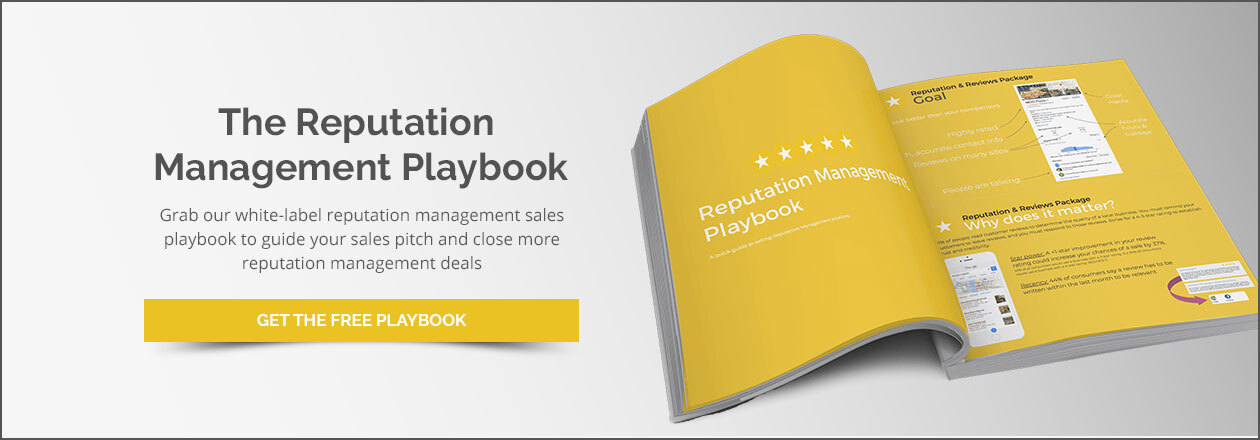Key Takeaways
- If you want to limit the impact of your client’s reputational risk, you have to start by understanding the risks they face.
- A thoughtful 360-degree reputational risk management plan can be the difference between a brand thriving or being destroyed by a negative incident.
- The keys to reputational risk management include prioritizing transparency and honesty in customer communications, maintaining an active and positive social media presence, and responding to negative events as swiftly as possible.
Want to avoid reputational damage to your small and medium-sized (SMB) business clients? To do that, you need to know what risks SMBS face when it comes to their reputations, what the potential repercussions are, and how you can best prevent or manage reputational risks if they occur.
Download “Why reputation management matters: A churn study” for data-based strategies on retaining clients longer using online reputation management.
Just as our personal reputations impact our outcomes in life, your SMB clients’ business reputations can meaningfully impact their opportunities—and their bottom line. Whether they experience negative publicity, a loss of business, or a decrease in trust in their offering, reputation risk can be devastating for SMBs. That’s why we’ve created this guide: so marketing agencies like yours can prevent, monitor, and mitigate reputational risk for clients, and keep that proverbial halo on top of their brand name.
Understanding Reputational Risk
Let’s start by clarifying what we actually mean when we talk about how to mitigate reputation risk. Here are some of the most common sources of adverse impacts to the reputations of SMBs:
- Ethical lapses or misconduct by employees, business owners, and others associated with the business
- Product recalls or recurring quality issues, especially when these are widely discussed online or in product reviews
- Data breaches or cyberattacks that put customer data at risk
- Environmental or social controversies
- Negative media coverage or social media backlash in response to company activities
- Legal or regulatory violations that hamper the perceived trustworthiness of the business
There’s a large element of subjectivity when gauging reputational damage, but one of the most irrefutable gauges of how much damage was done is often your client’s sales numbers. As customers lose trust and confidence, the bottom line typically takes a hit.
How to mitigate reputational risk proactively
Responding to a crisis after the fact can result in rushed, poorly thought-out reactions. Taking the time to put a risk management plan in place proactively means that in the unfortunate event of a negative incident, your agency and clients can confidently jump into action. Here’s what you should consider when determining how to reduce reputational risk:
- Identify and assess all potential sources of reputational risk that your SMB clients face in the regular course of operating their business
- Develop a plan to address and mitigate each of the possible risks you come up with
- Decide how you’re going to monitor and measure the effectiveness of your risk management strategies to ensure they’re limiting the impact of risk as effectively as possible
When working with local SMBs, you’ll likely find that most of them don’t think about how to mitigate reputation risks too much, because they perceive this to a problem for the big players. But the truth is that risks can impact businesses of all sizes, and a rock-solid plan for mitigating reputational risk can protect their organization when it’s most vulnerable.
Get ahead of the problem: Identifying potential reputational risks
When you start working with a new reputation management client, a good place to start is by going through a standard risk assessment exercise. We’ve got you covered with a step-by-step walkthrough that you can repurpose when working with SMBs:
1. Identify all key stakeholders
Identify all of the key stakeholders, who are connected to your client’s business. These include:
- Existing and prospective customers
- Employees and others who work with the business, such as contractors or freelancers
- Suppliers and vendors
- Regulators and professional organizations to which they belong
Larger businesses will also have shareholders on their list as prominent stakeholders, but for any type of marketing agency that work with SMBs, you’re unlikely to encounter this scenario.
Alright, so you’ve got your list of stakeholders. Now what?
Determine what the members of each group on your list expect from your client, and how the organization’s actions could impact their perception of your brand. What do they value most about the business? Why do they associate with it over other competitors? Getting familiar with stakeholder expectations makes it easier to jump into the next step, risk assessment.
2. Conduct a thorough risk assessment
Now that you’ve identified who matters when it comes to managing reputational risk, you can dig into the risks that could jeopardize how your client is perceived.
This should include an analysis of both internal and external factors that could impact your SMB client’s reputation. Let’s take a look at some examples of both before getting into how to reduce reputational risk.
| Internal risk factors | External risk factors |
| Poor customer service | Competition from others in the market |
| Lack of adequate employee onboarding and training | Regulatory changes impacting the industry in which the business operates |
| Lack of transparency, especially about things that matter to customers | Economic or technological changes, such as competition from remote workers overseas |
| Lack of quality in product or service | Negative reviews, fake reviews or review bombing campaigns and other negative coverage |
| Data breaches | Changes to customer preferences and behaviors |
| Manipulating information, such as buying inauthentic Google reviews | Problems with vendors, suppliers, and other inputs into the client's product or service |
3. Monitor Social Media
Social media is more than a tool for getting a brand’s message out to its audience: it’s also an indispensable listening tool that can help SMBs identify risks, gauge changes in consumer opinion, and ultimately mitigate their reputational risk.
The best way to make use of social channels for the purpose of managing reputational risk is to use a social listening tool, like Vendasta’s Reputation Management. This way, you—and your clients—can see relevant conversations that are happening across the internet all in a single dashboard.
SMBs can also be proactive about Google review management and managing other social platforms. For example, they can link to their Google reviews in follow-up emails to encourage positive feedback. They can also dispute fraudulent reviews that may be hampering their reputation.
4. Plan for the best, but prepare for the worst
A crisis management plan is a bit like insurance in that it doesn’t seem very important until it’s needed. Suddenly, it can become exceedingly important.
Your crisis management plan should be based on the risks you and your client identified in the step above, with clear procedures for how potential problems will be dealt with and how stakeholders will be communicated with.
5. Keep a constant eye on reputational signals
By monitoring your client’s reputation and measuring relative metrics, it’s easier to spot risks and problems before they snowball into serious crises.
Consider keeping an eye on metrics like brand awareness, customer satisfaction, employee satisfaction and engagement, and social listening trends. Are all of these holding steady or improving? If not, dig into what potential risk might be impacting them.
Since you can’t turn off Google reviews, a better strategy is to keep an eye on them and respond to all reviews professionally—even the negative ones.
Reputational risk mitigation: Proven strategies
We’ve covered the basics of identifying the reputational risks that your clients face. Next, let’s take a look at some actionable tips that you can share with SMBs who want to be one step ahead of any potential PR crisis.
Internally publish the results of their risk assessment
You might have worked on a risk assessment directly with the owner of an SMB or their lead marker. But if multiple people are involved in the business, it’s a good idea to keep them in the loop too. When everyone has the same potential risks flagged in their minds, it’s much easier to avoid them (or to rapidly identify them if they do occur).
Establish clear crisis management responsibilities
When everyone is panicking, it’s much harder to get organized, delegate tasks, and effectively work together. SMBs can avoid this by clearly defining not just their crisis plan but also who will be responsible for what in a negative event.
Clearly outline the steps that should be taken by everyone in the organization so that if the plan ever needs to be put into action, everyone knows exactly what their next steps are.
Prioritize transparency and accountability
A crisis isn’t a good time to pass the buck, as tempting as it may be. Stakeholders, from customers to social media followers to vendors, want to know that they’re associating with a responsible business that can admit when they did something wrong and take the appropriate action to fix it.
Instruct clients to be upfront, clear, and own the situation. Doing so may even strengthen the sense of trustworthiness that stakeholders have about their brand.
Make reputation monitoring a regular practice
If reputation management and monitoring are scheduled regularly, it’s much less likely to be overlooked and forgotten when things get busy. Be sure to instruct your SMB clients on how to mitigate reputation risk and use any reputation management solutions you provide, and walk them through how to take a few minutes at an interval that makes sense for their business to check on how things are going.
Implement effective onboarding and training
Employees are often the face of your SMB client’s organization, so they play a huge role in reputation management.
New employee onboarding should include an in-depth session on the business’s values, policies, procedures, and reputational risk mitigation strategies. This should also be worked into periodic training sessions to keep the information fresh in everyone’s mind.
Build a positive corporate culture
By promoting ethical, responsible business practices and prioritizing the well-being of employees and other stakeholders, businesses can create an environment that fosters reputational risk mitigation. When people know the business has the best intentions, it’s much easier to understand and move past crises.
Beyond the initial setup: Monitoring and updating your client’s risk management plan
Like just about every other aspect of running a business, effectively managing reputational risk isn’t a one-and-done kind of thing. Once your client has a plan in place, it should be mentored regularly and updated as needed.
One way to do this is to set up Google alerts for their brand name so they can quickly respond to any negative articles or comments that come up. A third-party tool, like Reputation Management from Vendasta, makes this even easier by putting review management and social listening for all platforms under one roof.
It’s also a good idea to review the crisis management plan periodically to see if anything needs to be updated. Are there new employees? Have others left? Have the potential risks changed? Are Google reviews not showing up for some reason? All of these can impact the plan.
Finally, don't forget to communicate any updates or changes to your risk management plan to all relevant stakeholders. This ensures that everyone is on the same page and is ready to jump into action if it’s ever needed.


 By
By 